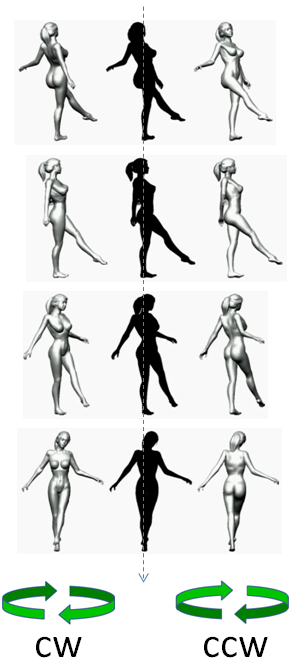In the Silhouette Illusion (video at the bottom), a silhouetted woman is seen spinning on one foot, her leg extended. The appeal of the illusion is in the way the woman is spinning – she can be perceived as spinning clockwise or counter-clockwise.
A psychology professor has found that the way people perceive the Silhouette Illusion, a popular trick that went viral and has received substantial online attention, has little to do with the viewers' personality, or whether they are left- or right-brained, despite the fact that the illusion is often used to test these attributes in popular e-quizzes.
Instead, Niko Troje says that any reported preference for seeing the silhouette spinning clockwise rather than counter-clockwise is simply dependent upon the angle at which the viewer is seeing the image.
"Our visual system, if it has a choice, seems to prefer the view from above," says Dr. Troje. "It's a perceptual bias. It makes sense to assume that we are looking down onto objects that are located on the ground below us rather than floating in the air above us."

Troje and his team found that a view-from-above bias (VFA) is what makes the viewer prone to seeing the silhouette in a certain way, not one's personality or whether the viewer is left- or right-brained. When shown the silhouette illusion, the study's 24 participants most often reported that the woman was spinning counter-clockwise if viewed from above, and clockwise if viewed from below. Thus, the viewing angle causes the difference in perception.
The theory can also be applied to other popular illusions, including Neckar Cubes, that are often used in online personality tests.
The movie demonstrates the depth ambiguity of the silhouette in the centre which can be interpreted in two ways. The two interpretations differ in the perceived order of the surfaces of the body in depth as can be seen in the figure below. The left column illustrates the interpretation in which we look at the figure's back in the first frame (top). As a consequence, the figure rotates clockwise as we go though the sequence of frames (from top to bottom), and we look at it from a slightly elevated viewpoint (10 deg). In the right column we illustrate the other interpretation. We look at the front of the figure in the first frame, the figure rotates counter-clockwise, and the viewpoint is 10 deg from below.
Citation: Troje, N. F. , McAdam, M. (2010) The viewing-from-above bias and the silhouette illusion. i-Perception 1:143-148





Comments